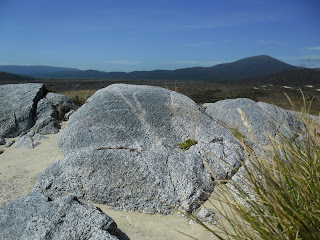I recently spent a couple of weeks on Rakiura/Stewart Island as part of a six week DOC/CNZ Wild Creations residency which will be spent researching southern Maori musical instrument possibilities, gathering materials, making instruments and then recording them on location around Rakiura. I will also be making reconstructions of Maori musical instruments found in museum collections that have providence from Murihiku (Otago), Ruaumogo (Fiordland) and Rakiura.
My first day on Stewart Island was spent at Oban where I took a trip out to Ulva Island bird sanctuary. I found some Neptunes Necklace seaweed pods that can be played as karanga manu (bird callers) and found that the local fantails were pretty interested in the sounds produced.
Next day I flew by helicopter to Hill Homestead at Mason Bay where I was to spend the next 11 days, gathering materials, making instruments and recording.
 |
| Workshop to the left, Homestead to the right. |
First on my list of things to do was to make a tuwiri (traditional Maori drill). I found a straight manuka stick and built four cross bars from inanga wood. I used a piece of vine to create a hoop that lies on the cross bar and provides momentum and balance to the tuwiri. I bound these parts together with twine. At first I experimented making pakohe (argillite) drill bits using a grossularite garnet hammer stone, with average success. I had better luck using quartz that I found on a granite outcrop behind Hill Homestead.
I kept on experimenting, drilling some soapstone using the tuwiri, with the aim of making a replica of a karanga manu (bird caller) in Otago Museums’ collection found at Glenorchy near Queenstown. I got some pretty good holes fairly quickly and then shaped the outside of the karanga manu using a flat granite grind stone.
 |
| Granite outcrop on Big Sandhill. Mt Rakaeahua is on the right in the background |
I kept on experimenting, drilling some soapstone using the tuwiri, with the aim of making a replica of a karanga manu (bird caller) in Otago Museums’ collection found at Glenorchy near Queenstown. I got some pretty good holes fairly quickly and then shaped the outside of the karanga manu using a flat granite grind stone.
This is the finished karanga manu.
I also made quite a few instruments from found objects, mostly found on the beach. I was lucky enough to find a Mollymawk Albatross from which I made this kōauau (flute). The criss-cross incision marks are very common on southern koauau toroa and also on many bird bone toggles.
And this shell worked well as a koauau. As you can see I have removed the spiral end of the shell.
Poroporo has a pith as so makes a good kōauau material, easily bored out by pushing out the pith.
I visited Mason Bay Beach every second day or so to see what had been washed up, and the variety from day to day was note worthy. One day it was mostly wood, the next kelp, another it was birds.
I did some preliminary experiments making instruments with kelp. I have left some koauau and a trumpet experiment to dry over the next month. Hopefully they will give me some results when I return.
I was lucky enough to get hold of some pūnui (būnui southern dialect) that is very rare on Rakiura and only found in private gardens. It is common on the offshore islands and was used to inflate the poha bags used to store mutton birds. As it is hollow it is possible to easily make a kōauau from pūnui and when talking to Phillip Smith, a local mutton birder among other things, he said they used to make flutes from it as children. He warned that pūnui can have laxative properties if played as a kōauau too much!
I did some preliminary experiments making instruments with kelp. I have left some koauau and a trumpet experiment to dry over the next month. Hopefully they will give me some results when I return.
I was lucky enough to get hold of some pūnui (būnui southern dialect) that is very rare on Rakiura and only found in private gardens. It is common on the offshore islands and was used to inflate the poha bags used to store mutton birds. As it is hollow it is possible to easily make a kōauau from pūnui and when talking to Phillip Smith, a local mutton birder among other things, he said they used to make flutes from it as children. He warned that pūnui can have laxative properties if played as a kōauau too much!
I’m off back to Rakiura the first two weeks of April so I will keep you posted what I make next!
Alistair
Alistair





